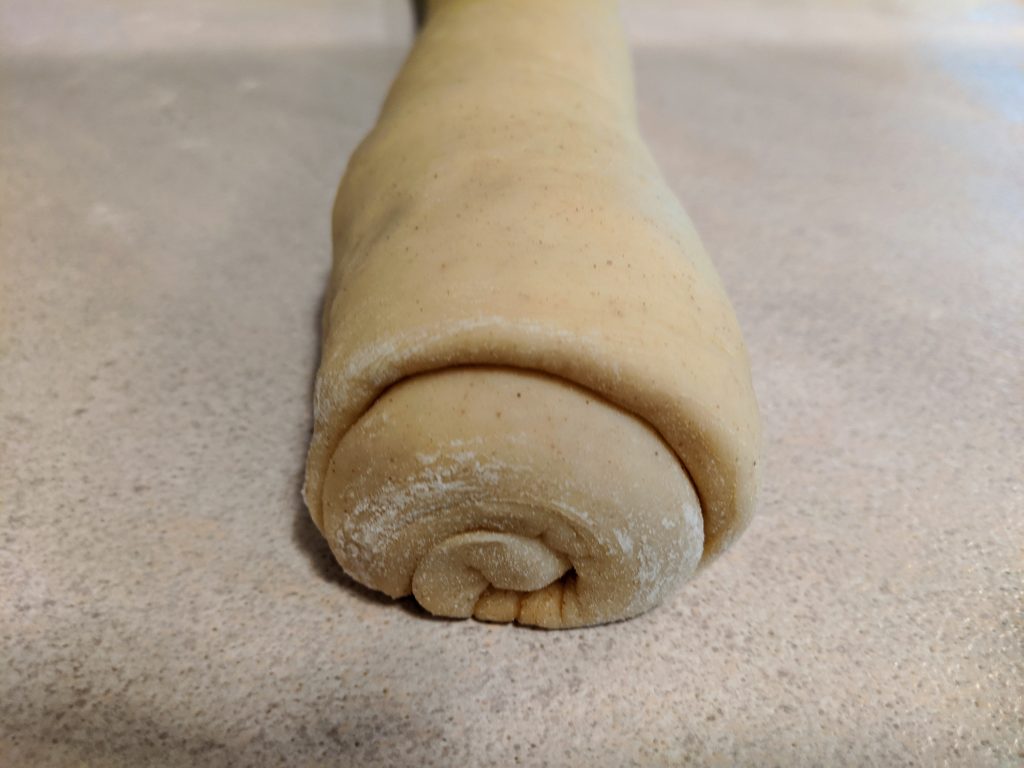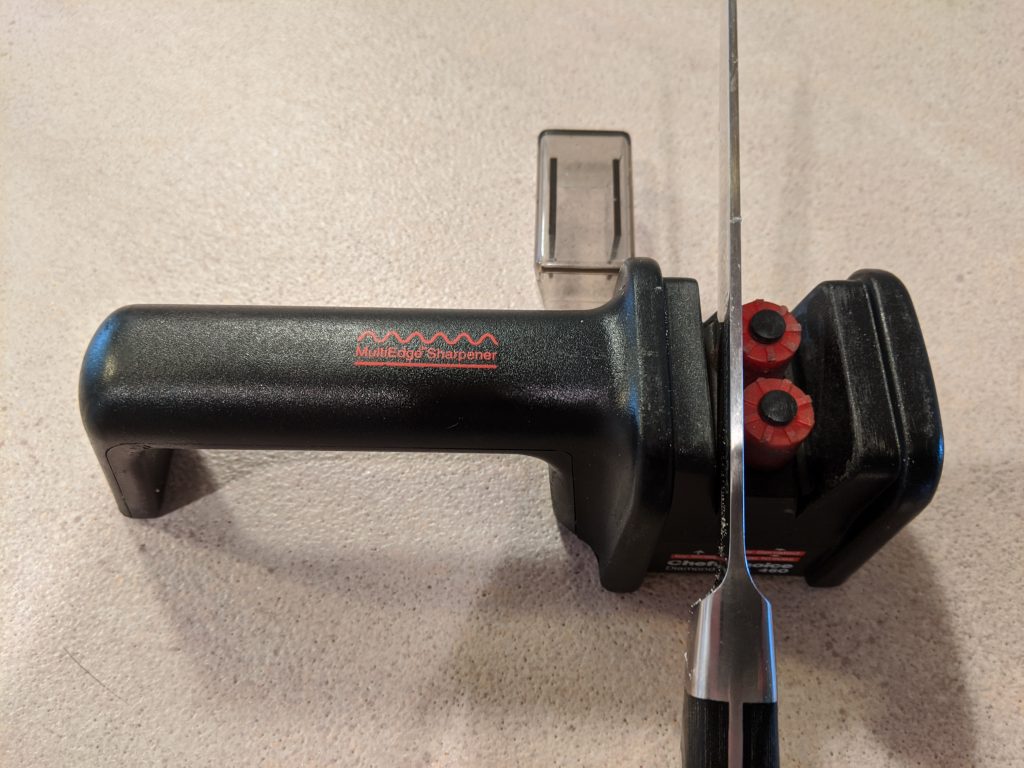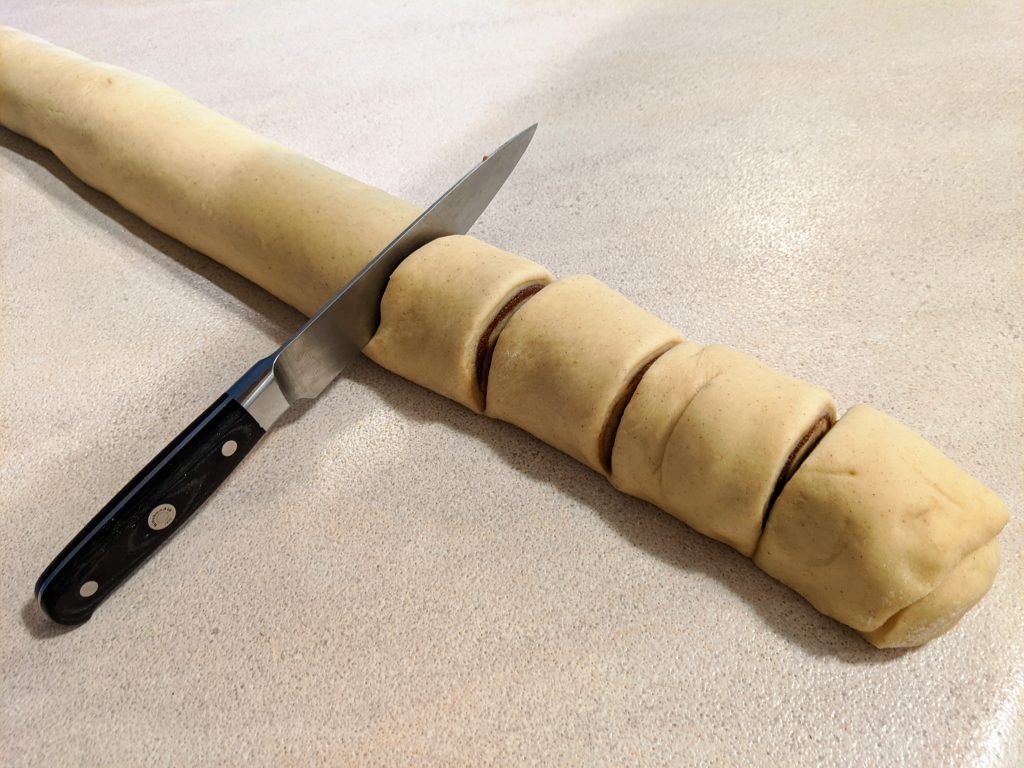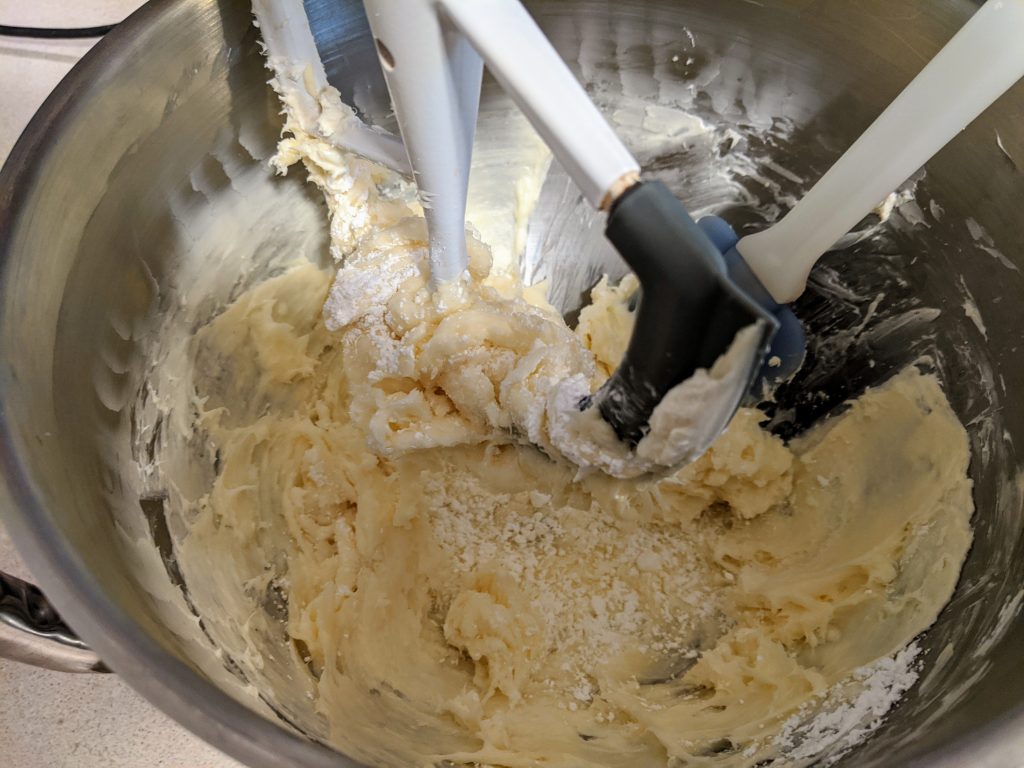
Melt the butter in a small pan or the microwave, and set aside.

Gently heat the milk in a small pan or the microwave. Be careful not to scald it or overheat it. You want it between 105° F and 110° F for growing the yeast.

Put the milk in your mixer bowl and stir in 1 tablespoon of sugar to support the growth of the yeast.

Sprinkle the yeast on the surface of the milk and wait a few minutes until the milk dampens all of it. Then stir the yeast thoroughly but gently into the milk.
Wait 5 minutes.

If you look closely, the mixture should now be foamy due to the action of the yeast.

If you’re not using a stand mixer, you can do the next few steps with a heavy spoon.
Add the sugar, melted butter, eggs, and vanilla to the yeast mixture, and stir with hook or spoon until combined.

Measure 4 cups of all-purpose flour, or weigh out 520 grams.
This is the minimum amount of flour for this recipe. Later you can adjust it to get the exact right amount.

Add the flour, salt, and cinnamon, and stir with the dough hook. Start it on low so flour won’t spray around the room, and speed it up a little as you go.

This will probably happen several times: If the dough sticks to the side of the bowl, the bottom of the bowl, or high up on the dough hook, stop the mixer and use your flexible spatula to push the dough back into the middle.
Be sure to push the spatula all the way under to the middle of the bottom of the bowl.

Once the dough forms into a large ball, knead the dough with the dough hook of your stand mixer.
If you prefer, you can transfer the dough to a floured surface and knead it with your hands.

If the dough sticks to the bottom of the bowl or feels sticky to your fingers, add a spoon of flour at a time, waiting until each spoon is incorporated, until the dough is smooth.
Knead 3 to 5 minutes

Knead the dough until it is smooth and elastic.

Place the dough on a floured surface, and form the dough into a ball with floured hands. Smooth the top of the ball with your hands until the surface is stretched and smooth, pressing the dough under the ball.
The yeast will rise more easily with an unencumbered smooth surface.

Spray a large bowl lightly with cooking oil spray, place the dough in the center, smooth side up, and hit it with one last quick squirt of the cooking oil spray.

Cover the bowl with a kitchen towel to keep stuff out and the moisture in.
Wait until the dough has doubled, or nearly doubled, about 30 minutes.
Perform the following steps while you’re waiting:

Cut a piece of parchment paper a little bigger than the top plus the sides of your 9″ X 13″ glass baking pan.

Spray the top of the parchment paper lightly with cooking oil spray.

Place the brown sugar, cinnamon, and butter in a small bowl.
If you want to save some time and effort, mix only the sugar and cinnamon. Melt the butter, brush it on the dough, and evenly sprinkle and press on the sugar mixture. But you will get some gooey stuff in the bottom of the pan due to butter running out.

Mix the filling thoroughly with a fork.

After 30 minutes, the dough should have doubled. If not, it’s okay to wait a little longer.

Place the dough on a floured surface and roll from the center. Flour the rolling pin and your hands. If things start to get sticky, sprinkle extra flour over the dough, or flour the rolling pin again.

Roll the dough out into a 24″ X 12″ rectangle, and square off the corners as much as you can. Measure it! Try to make the thickness even all over, about 1/4″.

Spray a flexible spatula with cooking oil spray.

Spread the filling evenly over the dough. It’s not easy! You’re going to have to work a while to get it even as smooth as in the picture, but it’s worth it. Be sure to leave about 1/4″ around the edges so it won’t leak out.

Carefully roll the dough up as tightly as you can, so that you end up with a 24″ long cylinder.

Take the time to mark off a dozen 2″ pieces.

Sharpen your utility knife especially for the next step. It’s a lot easier and cleaner with a sharp knife!

Using your sharpened knife, cut the dough into a dozen pieces on the marks.

Place the rolls on the oiled parchment paper in the baking pan in 3 rows of 4 rolls. Trim the parchment paper with scissors so it doesn’t stick out of the pan.

Cover the rolls with a kitchen towel to keep stuff out and moisture in, and let them rise again.
Wait about 30 minutes.
Preheat oven to 350° F with the rack in the center.

The rolls will be nearly doubled in size.
Bake them in the preheated oven until golden brown.
Bake 18 to 20 minutes.
Perform the following steps while you’re waiting:

Cream the butter and cream cheese with the paddle of your mixer until smooth.

Add the vanilla extract, orange extract, salt, and powdered sugar, and beat together until smooth. Speed the mixer up to medium for a few seconds to really smooth it out.
As pictured, you’ll have to use your spatula to scrape the sides of the bowl one or more times.
It’s easier if you don’t add the powdered sugar all at once. Add it about a third at a time.

Keep the icing out at room temperature so it will be easy to spread.

When the rolls look done, check the ones in the center because they finish last. They should be baked all the way through. Add time in increments of at least two minutes so the oven will stay hot. If they get too brown before they’re done, cover them loosely with foil.
Once the cinnamon rolls are golden brown, take them out of the oven. Spread the icing on them right away so it will ooze down into the cracks.
Let them cool a while in the pan and serve while still warm!